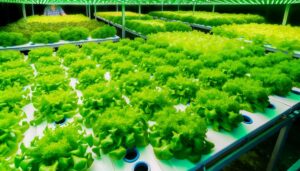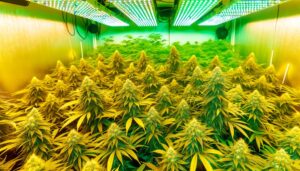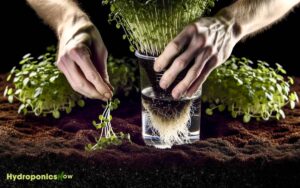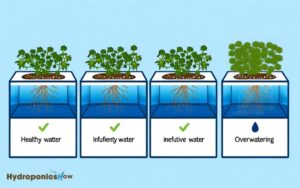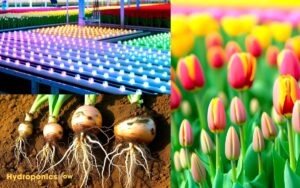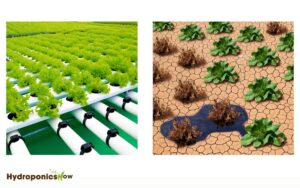5 Key Benefits of Hydroponics vs Soil in Planting
In addition, hydroponics provides significant benefits over traditional soil planting. It enables faster plant growth and up to 30% higher yields by ensuring precise nutrient and water delivery.
Water efficiency is greatly improved, using up to 90% less water. Hydroponics optimizes space utilization, making it ideal for urban farming.
This method offers better control over pests and diseases, and it eliminates dependence on soil quality, which enhances agricultural productivity in various environments.
Moreover, nutrient control and ecosystem benefits like reduced soil degradation and conserved water resources make hydroponics a superior, sustainable farming practice. To explore more, continue further.
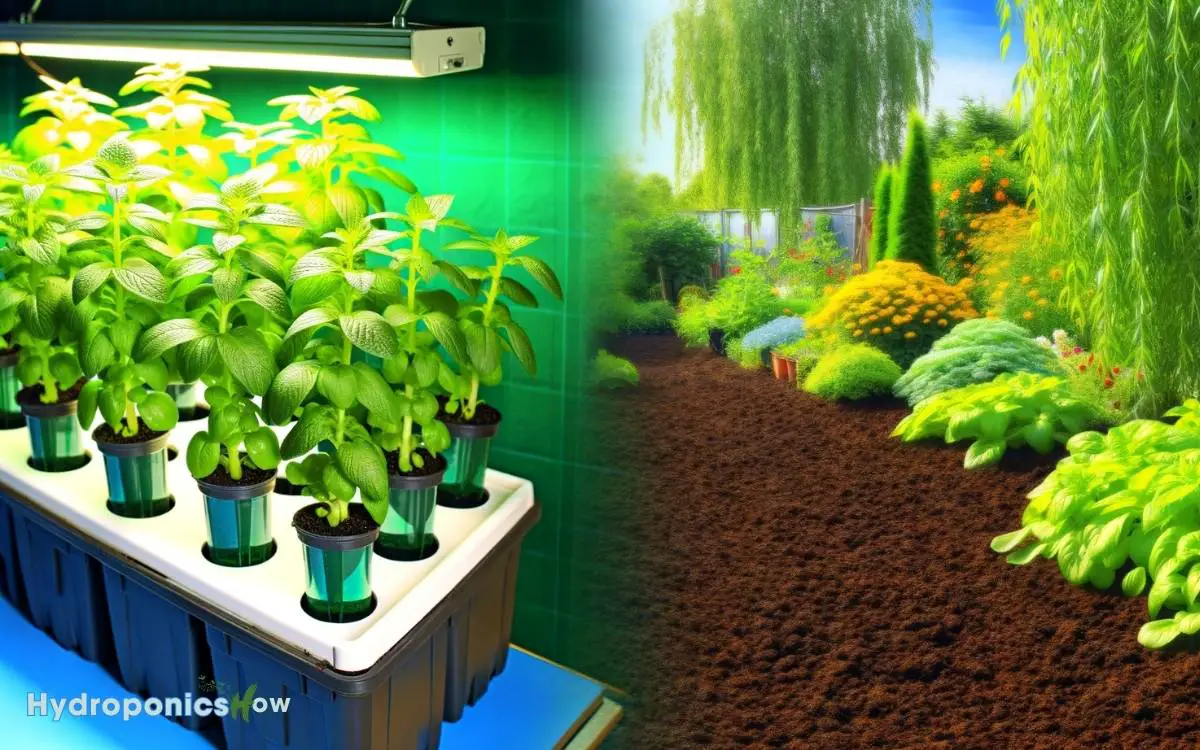
Key Takeaways
Faster Plant Growth
In comparing hydroponics to soil planting, evidence suggests that hydroponics often results in faster plant growth due to the optimized delivery of nutrients and water directly to the plant roots.
This method allows for precise control over nutrient concentrations and pH levels, eliminating the variability inherent in soil-based systems.
Research indicates that hydroponic systems can reduce the growth cycle of plants by up to 25%, as nutrients are readily available in an aqueous solution, facilitating quicker uptake.
Additionally, the absence of soil-borne diseases and pests reduces plant stress and further accelerates growth.
The constant availability of oxygen at the root zone in hydroponic setups also contributes to enhanced metabolic processes, leading to more rapid development.
Higher Yields
Achieving higher yields is another significant advantage of hydroponic systems over traditional soil planting. Empirical studies demonstrate that hydroponics can increase crop yields by up to 30% compared to soil-based methods.
This is primarily due to the optimized nutrient delivery system inherent in hydroponics, which guarantees that plants receive precise amounts of nutrients directly to their roots.
Additionally, controlled environments in hydroponic setups reduce the risk of pests and diseases, further enhancing plant productivity. The absence of soil-borne limitations allows for denser planting arrangements, maximizing space utilization.
Consequently, hydroponic systems can produce more crops per unit area, making them particularly advantageous for urban farming and areas with limited arable land. This leads to a more efficient, high-output agricultural practice.
Water Efficiency
Hydroponic systems are considerably more water-efficient than traditional soil-based agriculture, utilizing up to 90% less water. This efficiency stems from the closed-loop nature of hydroponics, where water is recirculated and reused, minimizing waste.
Traditional soil farming, by contrast, often involves significant water loss due to evaporation, runoff, and inefficient irrigation methods.
Research indicates that hydroponic systems can produce the same yield with a fraction of the water required by soil-based methods.
Additionally, hydroponics allows for precise control over water and nutrient delivery, reducing the likelihood of over-watering and nutrient leaching.
This precise management not only conserves water but also enhances plant health, making hydroponics a sustainable alternative in regions facing water scarcity.
Space Utilization
Space utilization in hydroponics presents significant advantages over traditional soil planting, particularly with regard to vertical growth potential and efficient area usage.
Studies indicate that hydroponic systems can increase plant density by up to 40%, enabling more productive use of limited space.
Additionally, vertical farming techniques inherent to hydroponics allow for multi-layer cultivation, thereby maximizing yield per square foot.
Vertical Growth Potential
Maximizing vertical growth potential, hydroponic systems offer a significant advantage over traditional soil planting by enabling more efficient use of limited space.
By employing vertical stacking and modular design, hydroponics can multiply plant density per square foot without compromising plant health or yield. This contrasts with soil-based systems, which are constrained by horizontal land availability and plant root space needs.
According to studies, vertical hydroponic farms can achieve up to ten times the yield of conventional farming methods within the same footprint.
| Metric | Hydroponics | Soil Planting |
|---|---|---|
| Yield per Sq. Foot | Higher | Lower |
| Vertical Adaptability | Excellent | Poor |
| Space Efficiency | High | Limited |
| Plant Density | Increased | Restricted |
This data underscores the potential hydroponics holds for maximizing space in urban and controlled-environment agriculture.
Efficient Area Usage
Building on the vertical growth potential discussed earlier, the efficient use of available area is another domain where hydroponic systems demonstrate superior performance over traditional soil planting.
In hydroponics, plants can be grown in stacked layers, markedly increasing yield per square meter. This method is particularly advantageous in urban settings where space is limited.
Studies indicate that hydroponic systems can produce up to 10 times more yield per unit area compared to soil-based methods.
Additionally, the absence of soil allows for closer plant spacing, optimizing the usage of horizontal space. Such efficient area utilization not only maximizes productivity but also reduces the environmental footprint, making hydroponics a sustainable alternative in modern agriculture.
Urban Farming
In the context of urban farming, the choice between hydroponics and soil planting profoundly impacts resource efficiency, crop yield, and sustainability.
Hydroponics, which involves growing plants without soil, typically results in higher yields per square meter due to optimized nutrient delivery and space utilization. This method allows for precise control over water and nutrient levels, reducing waste and maximizing efficiency. By eliminating unnecessary factors in hydroponics, such as soil-borne diseases and unpredictable weather conditions, plants can grow faster and healthier. As a result, hydroponic systems are becoming increasingly popular for sustainable and large-scale food production.
Studies indicate that hydroponic systems use up to 90% less water compared to traditional soil-based methods, an important factor in densely populated urban areas facing water scarcity.
Additionally, hydroponics minimizes the need for pesticides, thereby reducing environmental contamination.
Conversely, soil planting, while more traditional, often requires more space and water and may struggle with soil-borne diseases.
Therefore, hydroponics presents a compelling alternative for urban farmers aiming to maximize productivity and sustainability within limited spaces.
Controlled Environment
In addition, hydroponic systems offer a significant advantage in controlled environments, allowing for precise climate regulation, which can optimize plant growth and yield.
This method also enhances pest and disease control by limiting exposure to soil-borne pathogens.
Moreover, nutrient management efficiency is markedly improved, as the system delivers essential nutrients directly to the plant roots in a highly controlled manner.
Climate Regulation Advantage
One significant advantage of hydroponics over traditional soil planting is the ability to precisely regulate the growing environment, leading to ideal plant growth conditions year-round.
Unlike soil-based methods, hydroponics allows for the meticulous control of temperature, humidity, light intensity, and nutrient levels.
Studies have shown that such controlled conditions can result in faster growth rates and higher yields. For instance, research indicates that hydroponically grown lettuce can mature up to 25% faster compared to soil-grown counterparts.
Additionally, this environmental regulation mitigates the impact of seasonal changes and adverse weather conditions, ensuring consistent production.
Consequently, hydroponics offers a reliable solution for regions with extreme climates or limited arable land, enhancing food security and resource efficiency.
Pest and Disease Control
A significant benefit of hydroponics is the enhanced ability to manage pest and disease control through a controlled environment. This method minimizes exposure to soil-borne pathogens and pests, reducing the need for chemical pesticides.
Research indicates that hydroponic systems experience fewer pest-related issues compared to traditional soil planting.
The controlled environment allows for precise regulation of humidity, temperature, and light, which are critical factors in preventing the proliferation of pests and diseases.
Additionally, hydroponics often employs sterile growing mediums and closed-loop systems, further mitigating contamination risks. This results in healthier plants and higher yields, as the absence of soil-related challenges enables ideal growth conditions.
Consequently, hydroponics offers a more sustainable and efficient approach to modern agriculture.
Nutrient Management Efficiency
In a controlled environment, nutrient management efficiency is greatly enhanced, allowing for precise delivery of essential nutrients directly to the plant roots, which optimizes growth and reduces waste.
Hydroponic systems facilitate exact nutrient formulations tailored to specific crop needs, leading to consistent and accelerated plant development.
Conversely, soil planting often results in uneven nutrient distribution and potential leaching. Studies have demonstrated that hydroponically grown plants can achieve up to 20% higher yields due to this precision.
Additionally, the closed-loop systems in hydroponics recycle water and nutrients, minimizing environmental impact.
This method not only conserves resources but also ensures that plants receive a balanced diet, promoting robust and healthy growth. As a result, hydroponics offers superior nutrient management compared to traditional soil methods.
Pest and Disease Control
Effective pest and disease control in hydroponics systems often presents fewer challenges compared to traditional soil-based planting due to the controlled environment and absence of soil-borne pathogens.
The controlled parameters in hydroponics limit the entry and spread of pests, reducing the need for chemical pesticides.
Studies indicate that hydroponic systems exhibit notably lower incidences of common soil-borne diseases such as Fusarium wilt and root rot. In addition, the absence of soil eliminates nematode infestations, a common issue in conventional agriculture.
The use of sterile growing mediums and the ability to monitor nutrient solutions closely contribute to an integrated pest management strategy.
Consequently, hydroponic systems provide a more sustainable and efficient approach to maintaining plant health and minimizing crop losses.
Soil Quality Independence
One of the primary advantages of hydroponics is its inherent independence from soil quality, allowing for consistent and optimized growth conditions irrespective of geographical location.
This system bypasses soil-borne limitations such as poor fertility, contamination, and variable pH levels. As a result, crops can be cultivated in urban areas, arid regions, or places with degraded soils, ensuring food production is not hampered by local soil conditions.
| Aspect | Hydroponics | Soil Planting |
|---|---|---|
| Soil Dependency | None | High |
| Growth Consistency | High | Variable |
| Location Flexibility | Urban, Arid, Contaminated soils | Limited by soil quality |
| Soil-Borne Diseases | Low | High |
This independence enhances agricultural productivity and sustainability, making hydroponics a robust alternative to traditional soil-based farming.
Nutrient Control
Hydroponics offers precise control over nutrient delivery, allowing for the precise regulation of essential minerals and compounds necessary for ideal plant growth. This method circumvents the variability of soil composition, ensuring consistent nutrient availability.
Evidence indicates that hydroponic systems can optimize plant health and yield through tailored nutrient solutions.
Key advantages include:
- Customizable Nutrient Mix: Specific nutrient concentrations can be adjusted to meet the needs of different plant species.
- Reduced Nutrient Waste: Efficient use of nutrients minimizes runoff and environmental impact.
- Consistent Growth: Uniform nutrient supply promotes even plant development and reduces the risk of nutrient deficiencies.
Ecosystem Benefits
When comparing hydroponics to traditional soil planting, significant ecosystem benefits are evident.
Hydroponic systems demonstrate superior water usage efficiency, often reducing water consumption by up to 90% compared to soil-based methods.
Additionally, hydroponics mitigates soil degradation and allows for precise control of nutrient distribution, fostering sustainable agricultural practices.
Water Usage Efficiency
A comparative analysis reveals that hydroponic systems typically exhibit superior water usage efficiency compared to traditional soil planting, thereby offering significant ecosystem benefits.
Hydroponic systems can reduce water consumption by up to 90%, as water is recirculated and reused rather than lost through soil absorption and evaporation.
This efficiency translates into several key benefits:
- Conservation of Water Resources: Hydroponic systems use a fraction of the water required by soil-based methods, which is important in arid regions.
- Reduced Runoff and Contamination: The closed-loop nature of hydroponics minimizes the risk of nutrient runoff into local waterways.
- Enhanced Crop Yield: Efficient water usage supports optimal plant growth, leading to higher yields per unit of water used.
These points underscore the sustainability and ecological advantages of hydroponic cultivation.
Reduced Soil Degradation
In addition to superior water usage efficiency, hydroponic systems offer significant benefits in mitigating soil degradation, a critical factor for maintaining ecosystem health.
Traditional soil-based agriculture often leads to soil erosion, nutrient depletion, and contamination through pesticide and fertilizer runoff.
Hydroponics, by contrast, eliminates the need for soil, thereby preventing soil erosion and preserving land integrity.
Studies indicate that hydroponic systems can reduce pesticide use by up to 90%, thereby minimizing chemical runoff into surrounding ecosystems.
By decoupling plant growth from soil, hydroponics also mitigates issues related to land overuse and deforestation, which are contributing factors to soil degradation.
Consequently, hydroponics presents a sustainable alternative that supports long-term ecological balance and conservation of soil resources.
Controlled Nutrient Distribution
Controlled nutrient distribution in hydroponic systems allows for precise delivery of essential minerals and compounds directly to plant roots, thereby optimizing growth efficiency and minimizing environmental impact.
This method is inherently superior to soil planting due to several key advantages:
- Reduced Nutrient Runoff: Unlike traditional soil systems, hydroponics greatly decreases nutrient leaching into the environment, thereby preventing water pollution.
- Efficient Resource Use: The controlled environment ensures that nutrients are utilized more effectively, leading to reduced waste and lower overall input requirements.
- Consistent Growth Conditions: Precise nutrient management maintains consistent growth conditions, which can result in higher yields and better quality produce.
These factors collectively highlight the ecological and operational benefits of hydroponic systems over conventional soil-based agriculture.
Conclusion
Hydroponics heralds higher yields, hastened growth, and heightened water efficiency compared to traditional soil planting.
Space utilization and urban farming opportunities are greatly superior, while pest and disease control is streamlined.
Soil quality becomes irrelevant, enabling nutrient control that is precise and predictable.
This cultivation method curtails environmental constraints, contributing to ecosystem benefits.
Thorough comparisons confirm that hydroponics constitutes a commendable, contemporary cultivation choice, capitalizing on cutting-edge agricultural advancements.

